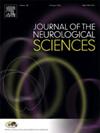Clinical, neurophysiological, and radiological characteristics of peripheral neuropathy in patients with rheumatoid arthritis: A cross-sectional observational study
IF 3.6
3区 医学
Q1 CLINICAL NEUROLOGY
引用次数: 0
Abstract
Neural involvement contributes to body dysfunction and compromised life quality in patients with rheumatoid arthritis (RA). We aimed to investigate the incidence, pattern, associations, predictors and best diagnostic tools of peripheral neuropathy (PN) in RA patients. We recruited 586 RA patients. Patients were categorized into three groups based on the presence (either clinically or subclinical) or absence of PN. PN was found electro-physiologically in 396 patients, 348 with clinical evidence of PN and 48 without clinical evidence. There were significant correlations between PN development and age, disease duration, involved joints, subcutaneous nodule, and VAS score. The mean cross-sectional areas were 9.55 ± 2.35, 9.62 ± 2.28, 9.19 ± 2.51 and 9.16 ± 2.43 mm2 in the right and left median and ulnar nerves, respectively. The number of affected small joints was an independent predictive factor of polyneuropathy and multiple mononeuropathy with an adjusted OR of 1.62 and 1.352, respectively. PN is highly prevalent in patients with RA, including those without overt symptoms or signs. It is highly associated with disease severity, disease duration, age, joint affection and erosion, VAS score and HAQ![]() D1. All types of PN could occur in RA. The US could be used for the diagnosis of PN in RA patients. The ultrasonographic references for the examined nerves were provided.
D1. All types of PN could occur in RA. The US could be used for the diagnosis of PN in RA patients. The ultrasonographic references for the examined nerves were provided.
类风湿性关节炎患者周围神经病变的临床、神经生理学和放射学特征:一项横断面观察研究
神经受累有助于类风湿关节炎(RA)患者的身体功能障碍和生活质量降低。我们的目的是调查RA患者周围神经病变(PN)的发生率、模式、相关性、预测因素和最佳诊断工具。我们招募了586名RA患者。根据有无PN(临床或亚临床)将患者分为三组。396例患者电生理检查发现PN, 348例有PN临床证据,48例无PN临床证据。PN的发展与年龄、病程、受累关节、皮下结节和VAS评分有显著相关性。左右正中、尺神经平均截面积分别为9.55±2.35、9.62±2.28、9.19±2.51、9.16±2.43 mm2。受影响的小关节数量是多发性神经病变和多发性单神经病变的独立预测因素,调整后的OR分别为1.62和1.352。PN在RA患者中非常普遍,包括那些没有明显症状或体征的患者。与疾病严重程度、病程、年龄、关节病变及糜烂、VAS评分及HAQD1高度相关。RA可发生所有类型的PN。US可用于RA患者PN的诊断。为所检查神经提供超声检查参考。
本文章由计算机程序翻译,如有差异,请以英文原文为准。
求助全文
约1分钟内获得全文
求助全文
来源期刊

Journal of the Neurological Sciences
医学-临床神经学
CiteScore
7.60
自引率
2.30%
发文量
313
审稿时长
22 days
期刊介绍:
The Journal of the Neurological Sciences provides a medium for the prompt publication of original articles in neurology and neuroscience from around the world. JNS places special emphasis on articles that: 1) provide guidance to clinicians around the world (Best Practices, Global Neurology); 2) report cutting-edge science related to neurology (Basic and Translational Sciences); 3) educate readers about relevant and practical clinical outcomes in neurology (Outcomes Research); and 4) summarize or editorialize the current state of the literature (Reviews, Commentaries, and Editorials).
JNS accepts most types of manuscripts for consideration including original research papers, short communications, reviews, book reviews, letters to the Editor, opinions and editorials. Topics considered will be from neurology-related fields that are of interest to practicing physicians around the world. Examples include neuromuscular diseases, demyelination, atrophies, dementia, neoplasms, infections, epilepsies, disturbances of consciousness, stroke and cerebral circulation, growth and development, plasticity and intermediary metabolism.
 求助内容:
求助内容: 应助结果提醒方式:
应助结果提醒方式:


